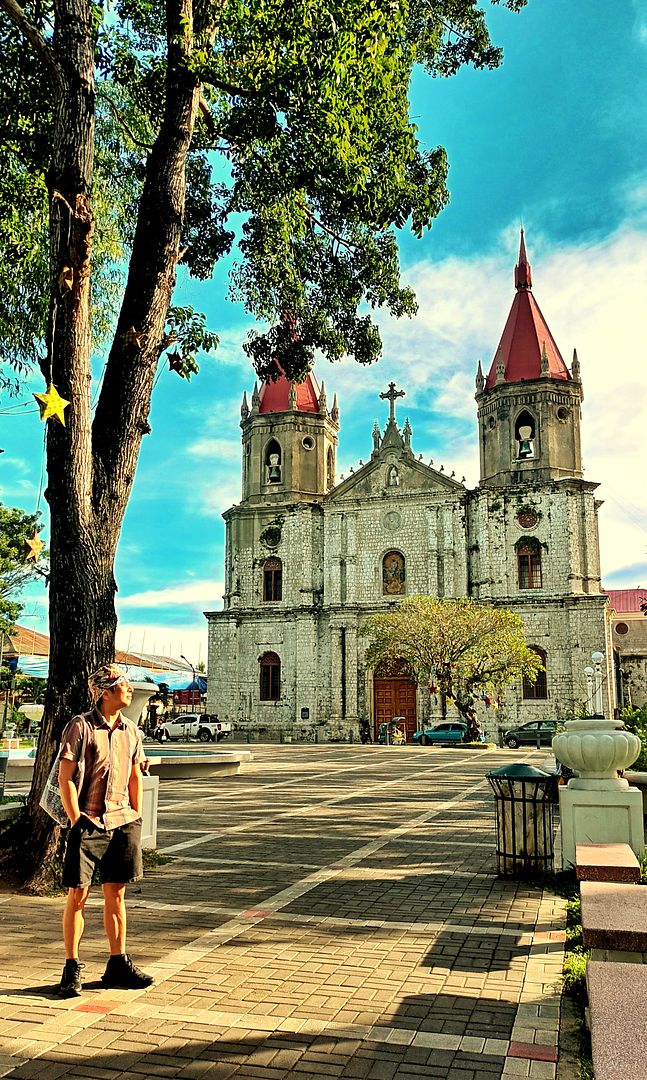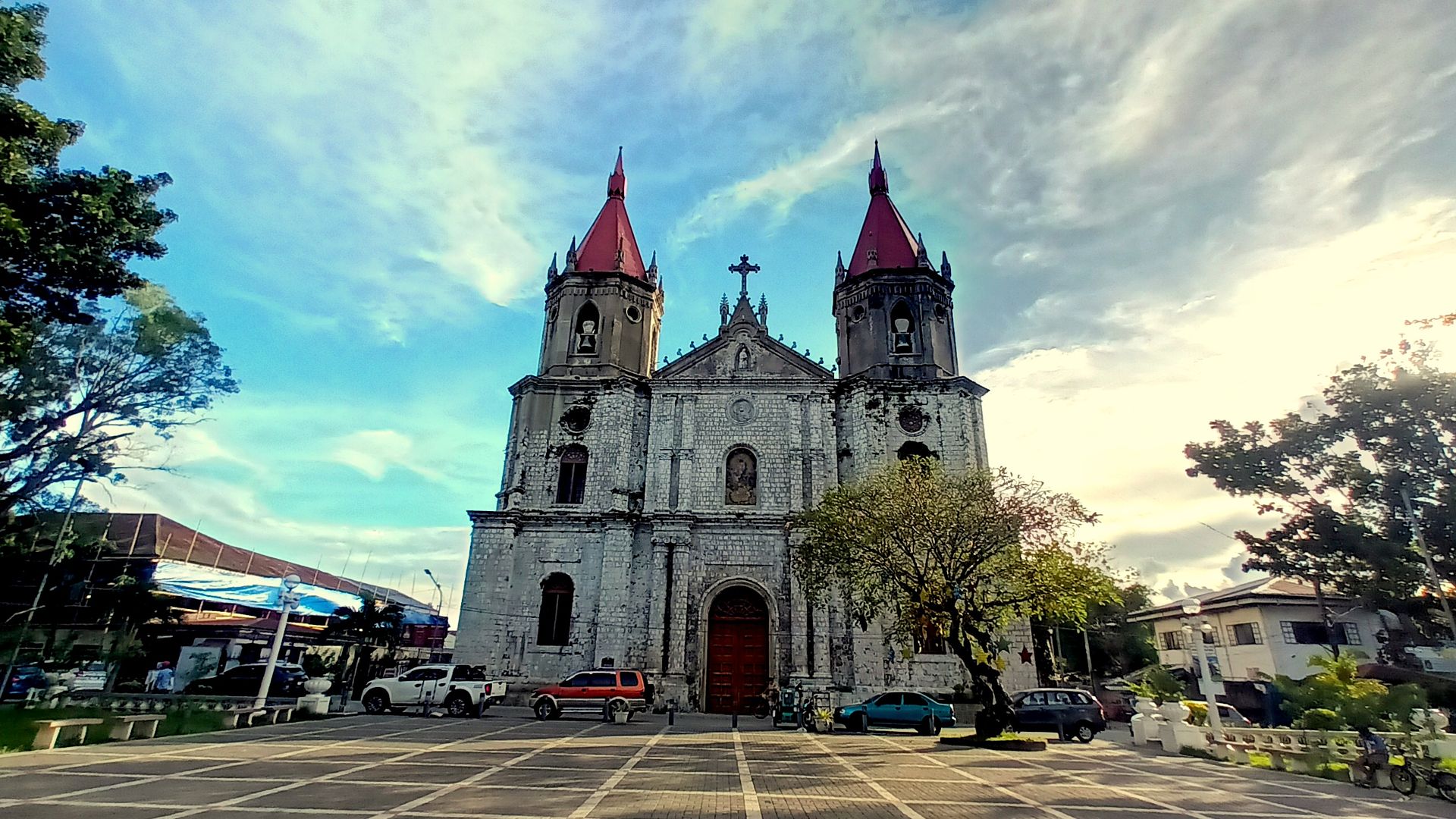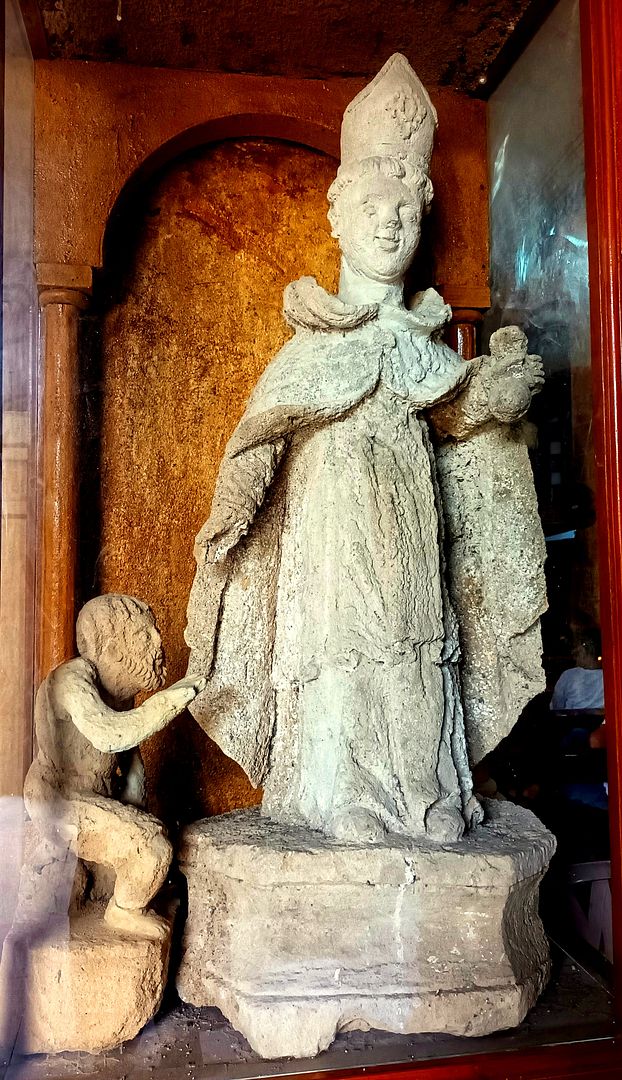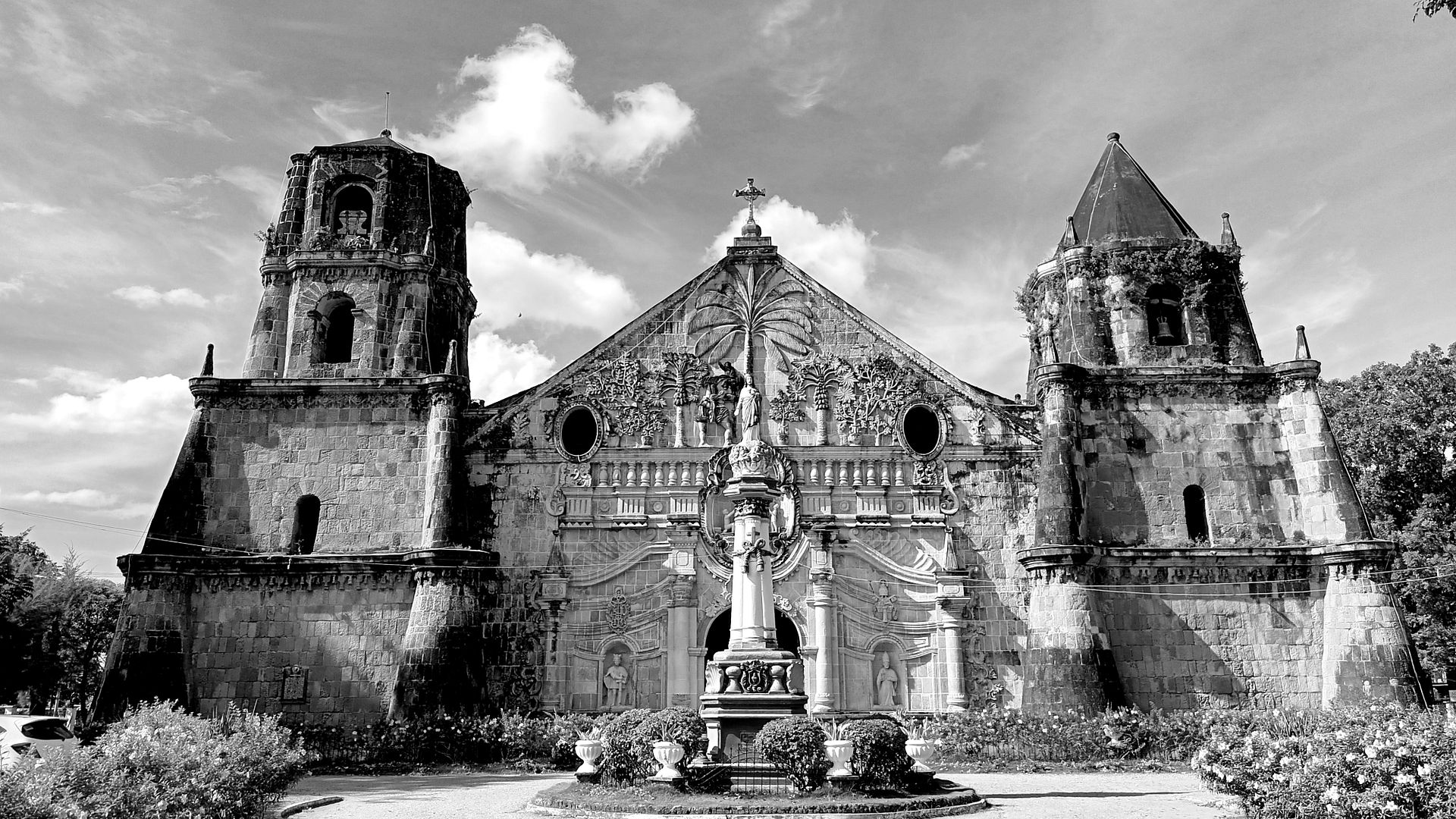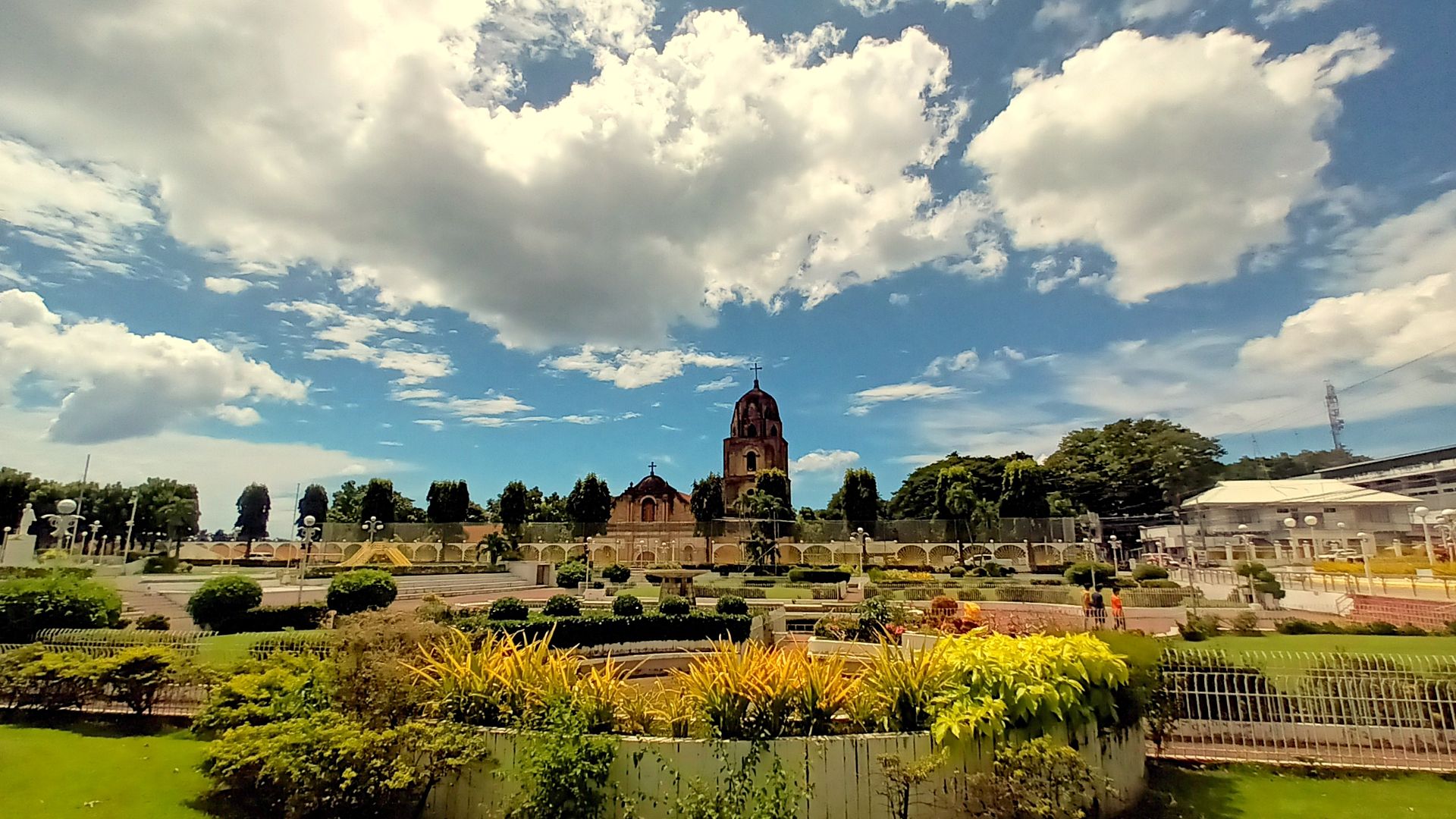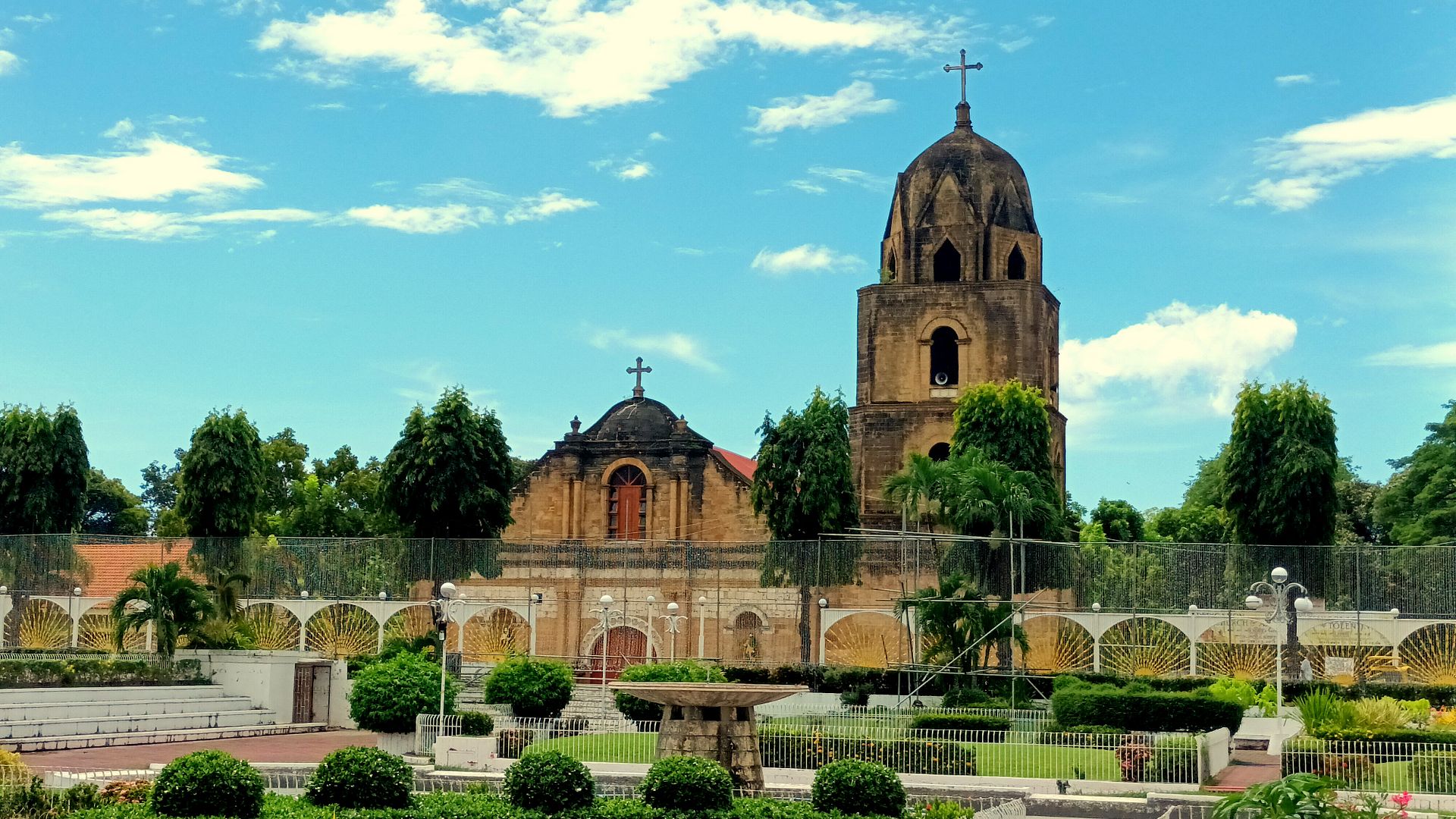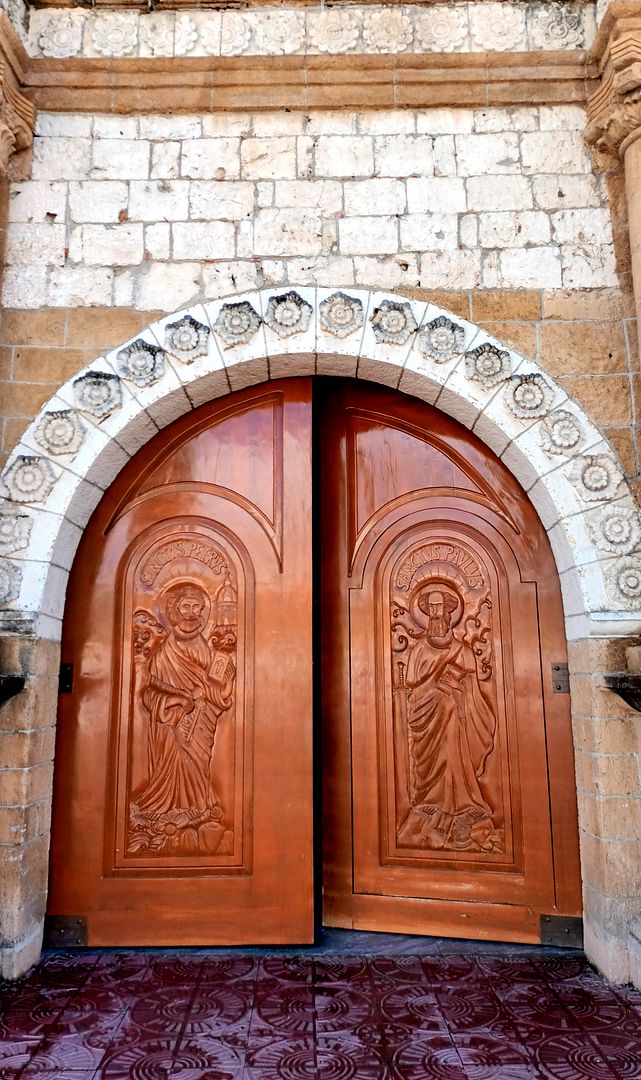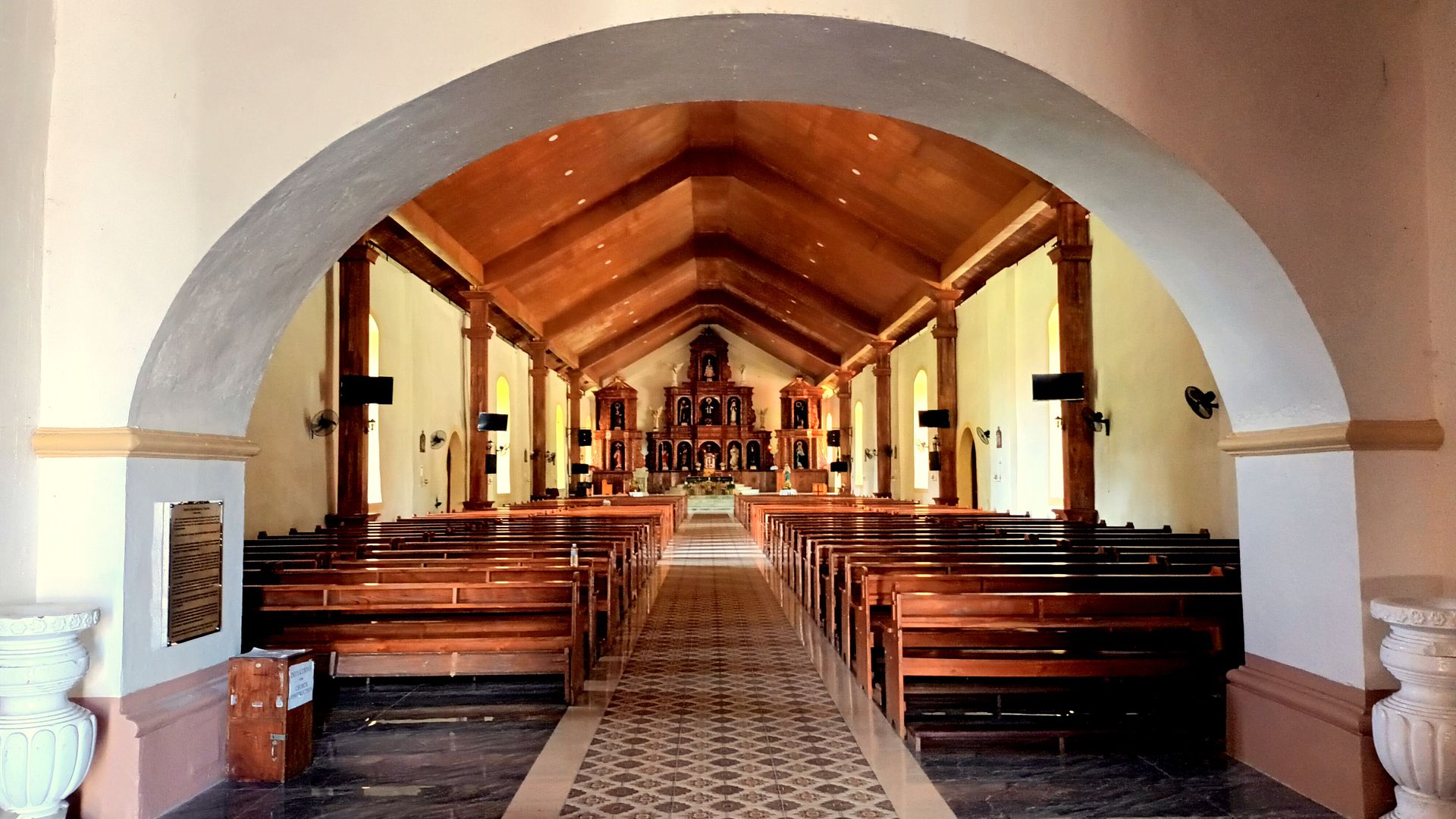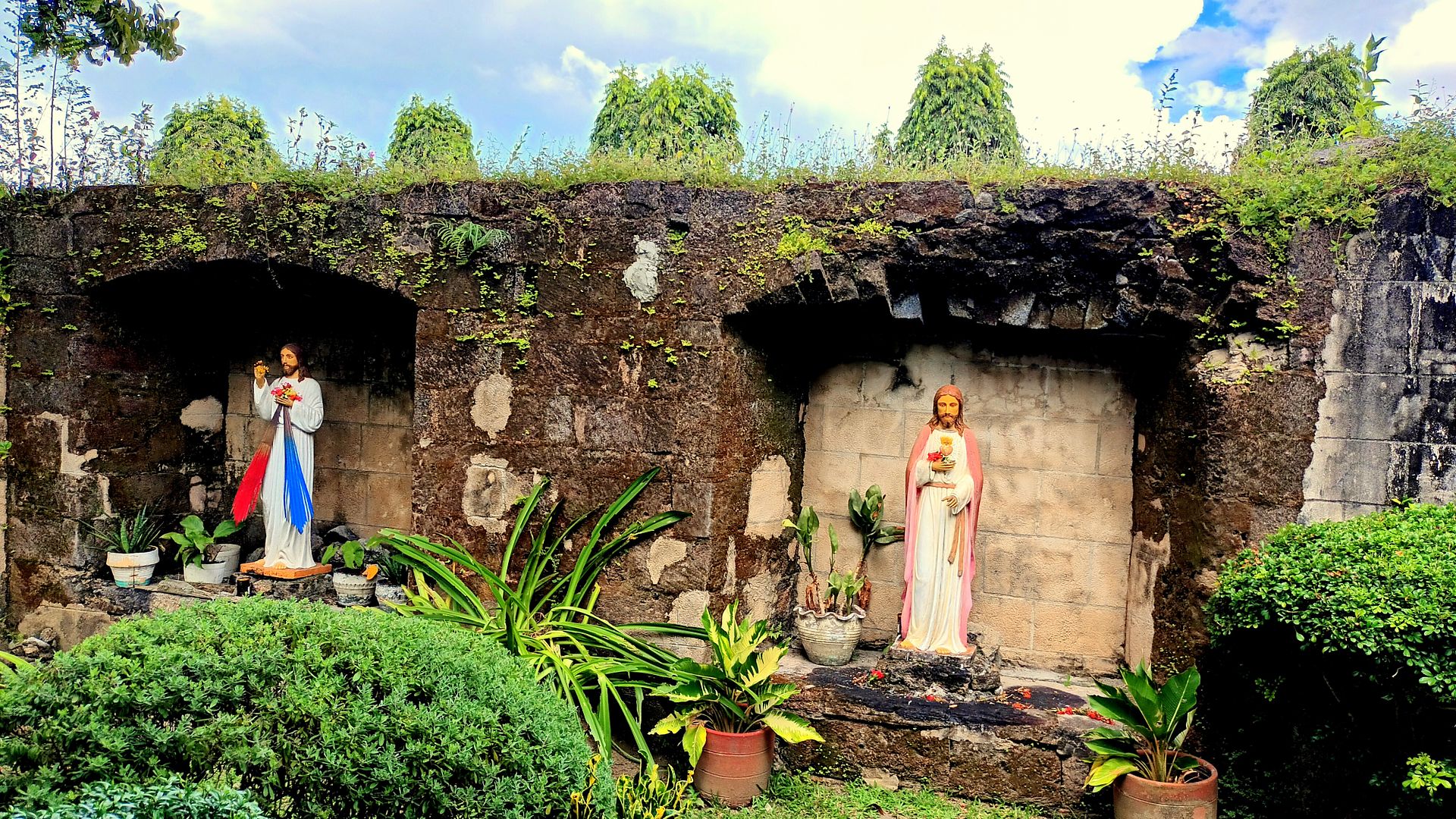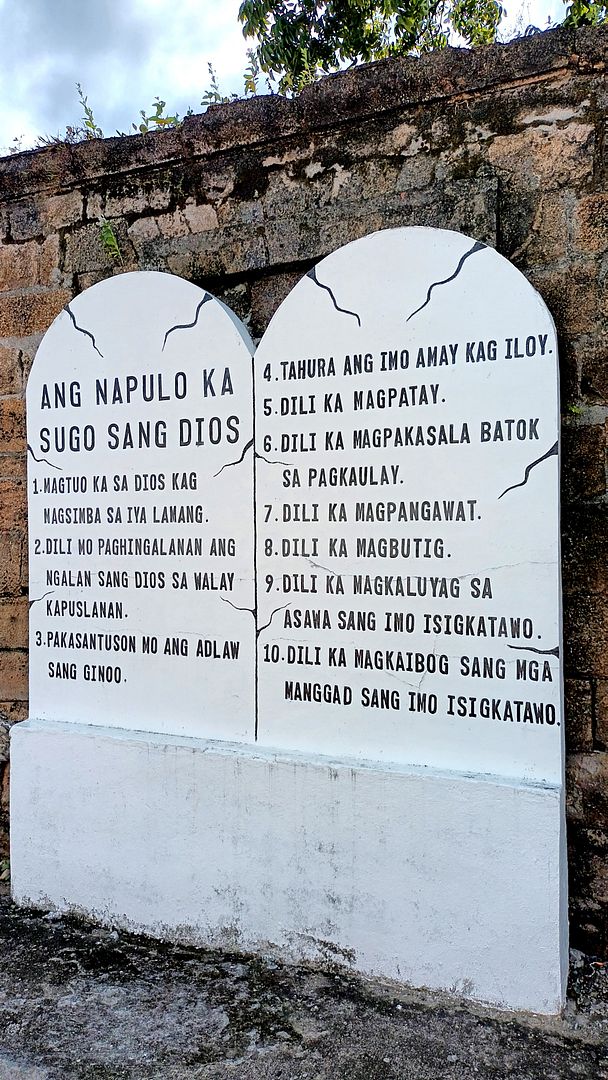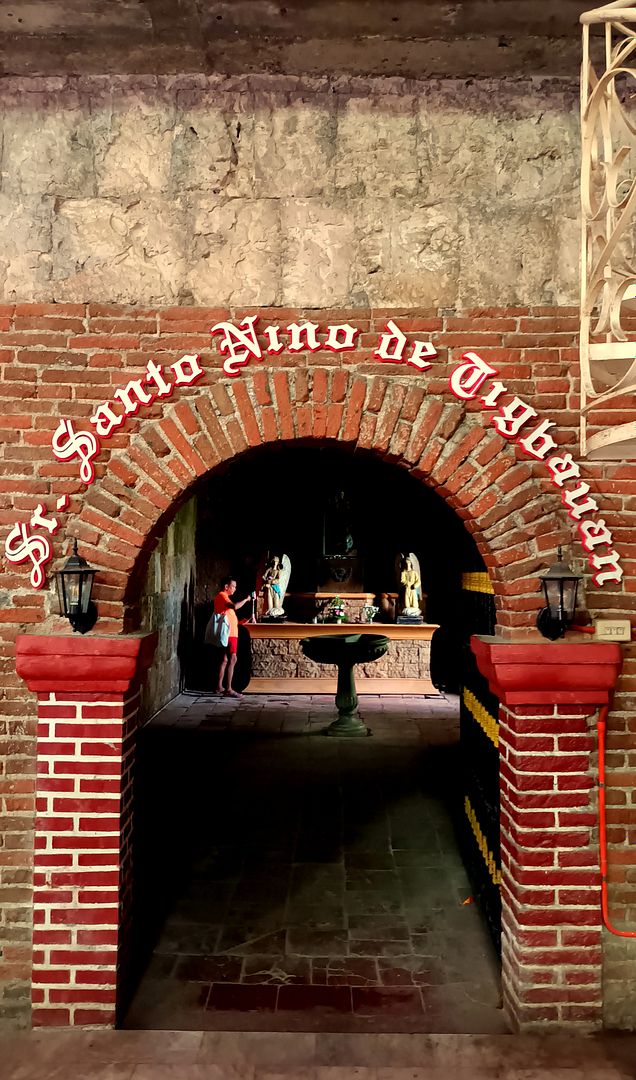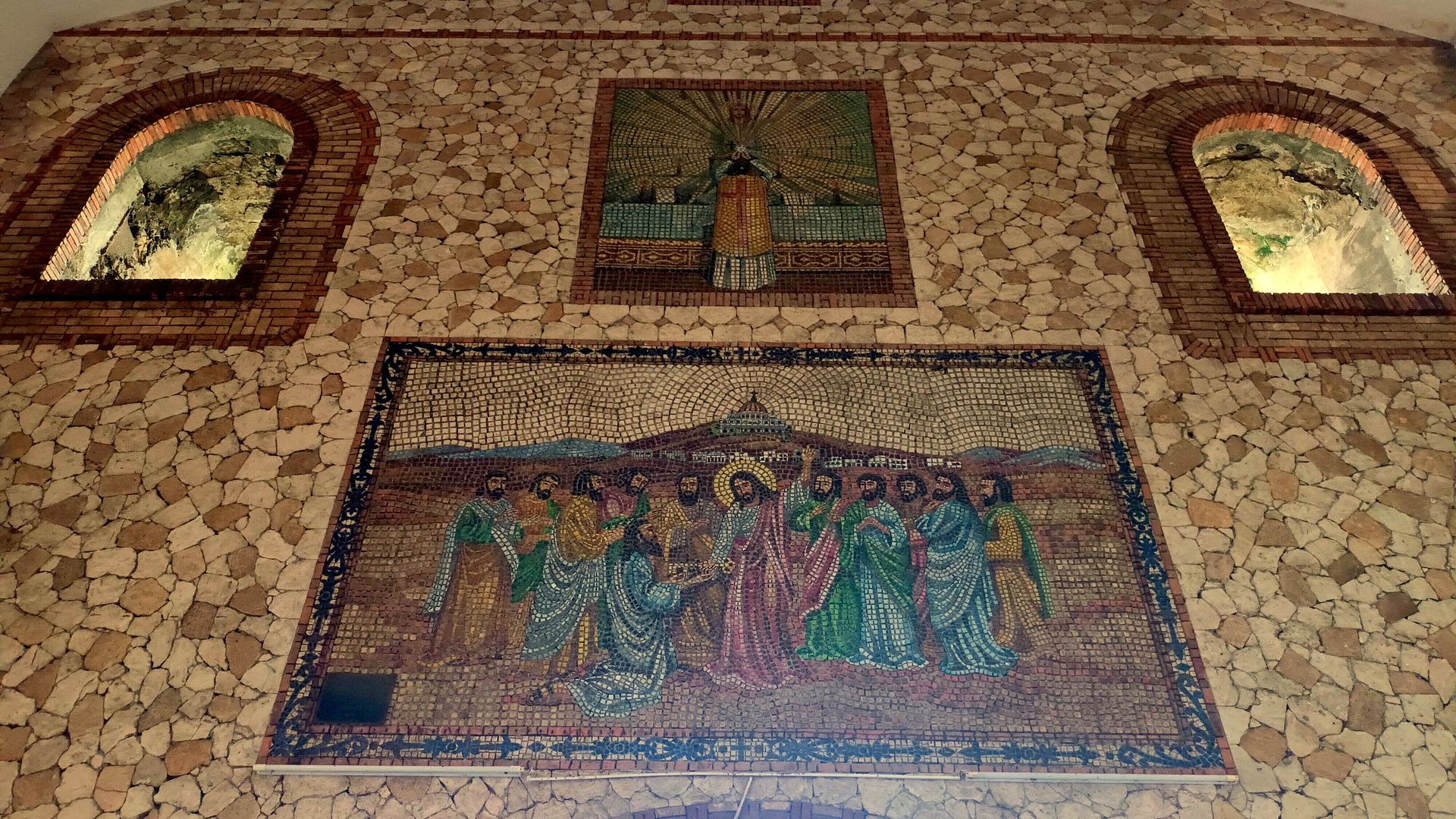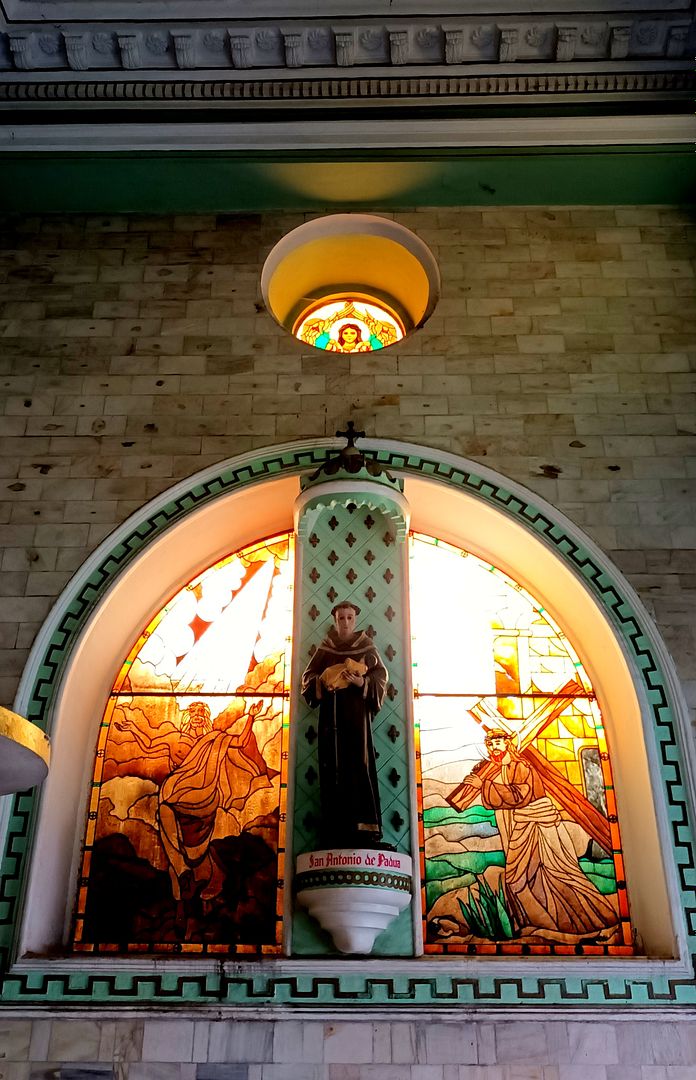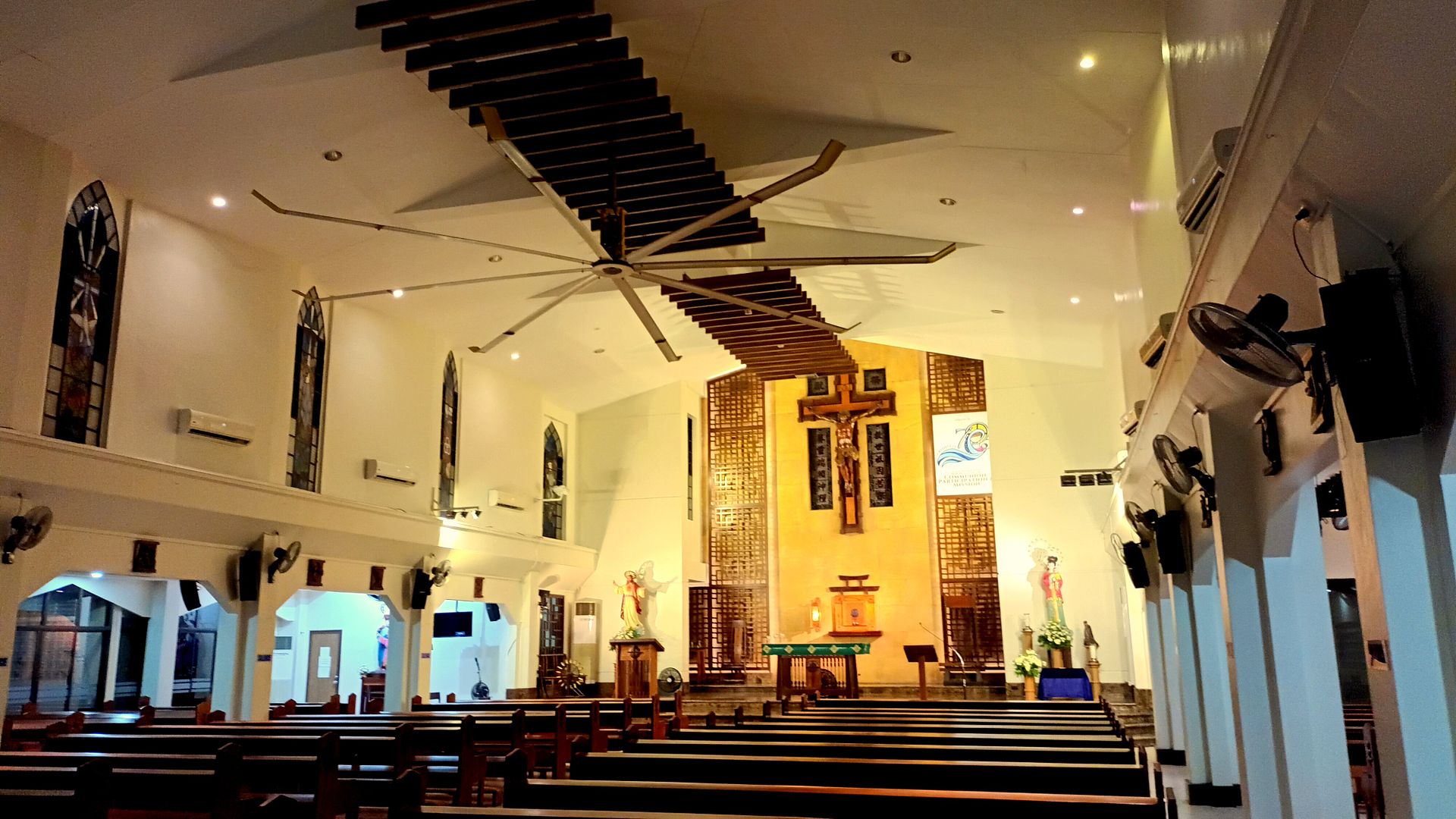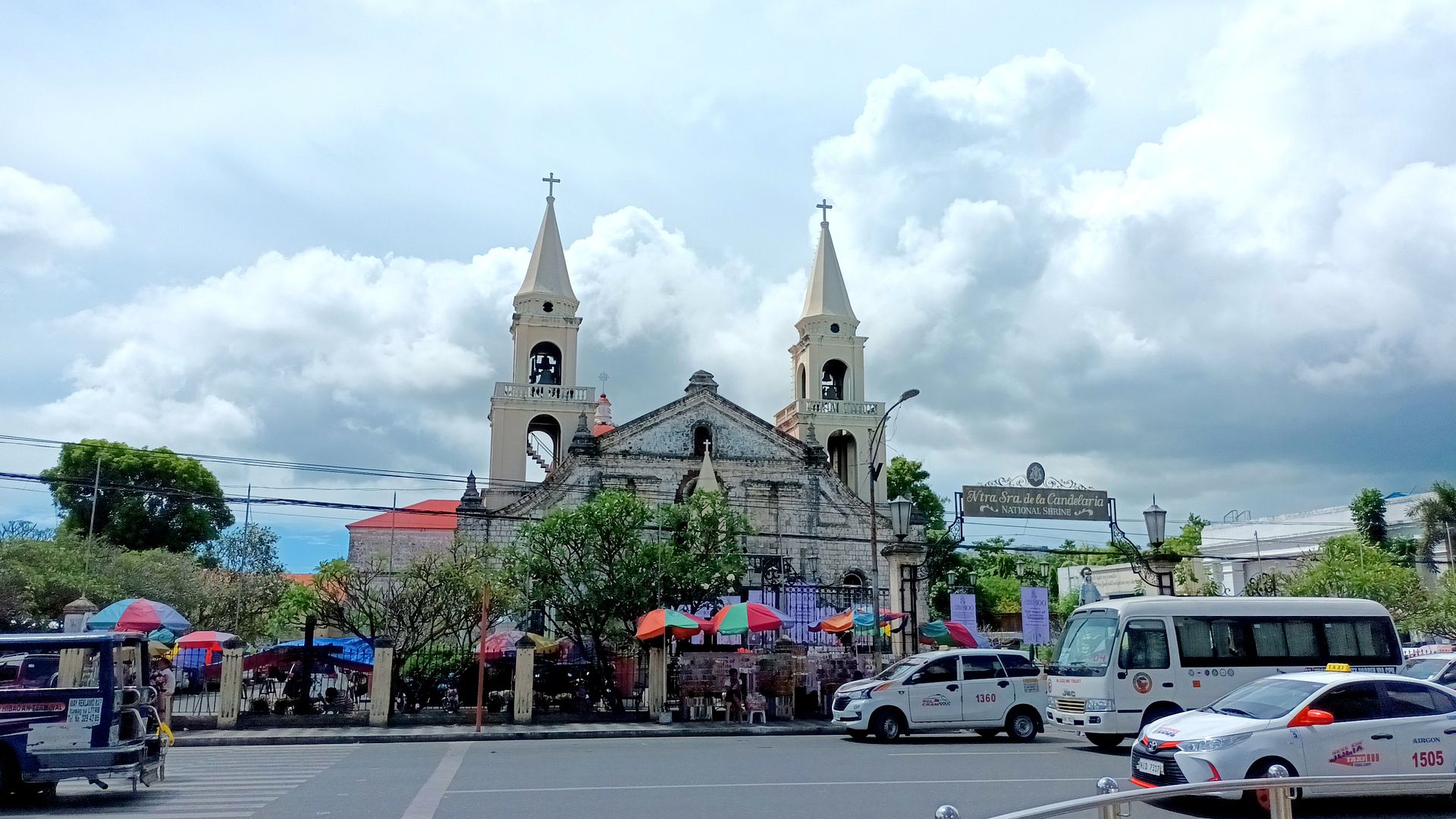Iloilo City / Miag-ao / Guimbal / Tigbauan, Iloilo, the Philippines
November 4 – 6, 2023
“The kingdom of heaven is like treasure hidden in a field,” Jesus once said. Who knew that the parable would take on a literal meaning at Tigbauan Church in southern Iloilo? Except that this precious secret was concealed by an altar, not in a field. Ki and I were exploring the empty church one rainy afternoon. He motioned me toward the back of the retablo. I did so and, lo, I beheld the most magnificent mosaic art I had seen in the country thus far. It was just one of the artistic wonders in a string of churches in this neck of the woods.
Molo Church (Saint Anne Parish Church)
Ki and I started our day early with a morning visit to Molo. We came to see the Spanish-era church, the district’s centerpiece since 1831. Its Gothic grandeur set against the rising sun was a dramatic sight. The twin spires seemed to reach for the heavens.
Up close, the two-level façade was giving medieval vibe: snake-skin masonry, classical pilasters, arched or circular niches, and a ringed cross on top. Alas, the hardwood main portal was still locked too early in the day. A lone kalachuchi tree in front lent a soft contrast to the imposing church.
Molo Plaza in front boasted of a fountain and a domed gazebo, circled by classical Greek statues and the scaffolding from its recent rehabilitation. The chirping birds sang along to Clair de Lune playing softly from loudspeakers. Debussy’s tender notes wafted through the breeze bearing memories of my late mother. She used to play this piano piece in my childhood.
Ki bought a pack of mini bibingka from a street vendor. The creamy brekkie was warm and fresh from the roadside grill. We couldn’t find coffee, so we just took it with the view of the church behind us and the elegant heritage house, Molo Mansion, across the street. It all evoked a different time and place so far removed from our home city.
Miag-ao Church (Santo Tomás de Villanueva Parish)
Sunshine soon went from soft to scorching. By then, we hopped on a Ceres Liner to take us further south to Miag-ao, famous for its fortress church. It was not our first visit, but what injustice to southern Iloilo had we given it a miss. Miag-ao Church, one of four UNESCO World Heritage Sites in the country, was a staple in any touristy visita iglesia.
The bus dropped us right by the uniquely yellow-orange church. It had been proudly standing there for 226 years, powering on through time, the elements, and wartime arson.
That iconic façade never got old. The bas-relief on ochre sandstone, carved by local artisans from centuries past, was a fusion of Baroque style and folk art. It famously situated St. Christopher of Asia Minor to a tropical environment.
The patron saint of travelers was depicted as a Filipino farmer carrying the Santo Niño and surrounded by endemic trees, most notably the centerpiece coconut and papaya bearing its distinctly-shaped fruit. The church’s patron saint, Sto. Tomas de Villanueva, was enshrined in a central niche.
The fan-shaped bell towers accounted for the church’s formidable look. Was it an anti-earthquake measure? A colonial defense against raiders from the south? A safe refuge for townsfolk during war and calamities? All of the above?
For Ki and I, the visit was a mommy memory. His mom may have been here in the 1950s when she was studying Nursing in Iloilo. I visited in 2011 with my own mom. That our mothers likewise saw the magnificence of Miag-ao Church put gladness in our hearts.
Unlike in Molo, the wooden doors had been flung wide open. An undated stone statue of, perhaps, the church’s eponymous saint greeted us from the entrance.
The priest’s voice faintly reverberated, though soon replaced by plaintive singing. A draped coffin lay in front of the altar. When it dawned on us, we awkwardly made a quick exit through the side door in deference to the dead.
Later, the mourners poured out of the church led by the horse-driven coffin. The funeral procession marched to the cadence of the band playing a dirge. It was a decidedly provincial ritual, rarely done nowadays in the city.
The mourners were replaced by formally dressed young men, apparently the entourage of an upcoming wedding. Witnessing this transition from mourning to marriage, I realized that the church had likewise witnessed this cycle of life and death for generations.
Guimbal Church (San Nicolas de Tolentino Church)
En route back to the city, we dropped by the town churches along the way. A friend’s elderly mother, Mommy V, lumped the towns together as TGM (Tigbauan, Guimbal, Miag-ao) in the order of their proximity from Iloilo City. I knew her to be a native of Guimbal and shared my photos in real time, taking her down memory lane. She gushed, “Our town is well taken care of because we have good leaders and God is good to us.”
Indeed, we were impressed with Guimbal Public Plaza. Sprawling yet entirely spick and span, the park was an outlier among the ill-maintained public spaces in this country.
To the photo of Oca Garin’s mural, she responded positively: “Mayor Oca was a kind leader, indeed! He and my Uncle Rudy were the best of friends. Tito Oca was a good relative and neighbor.” Ki, however, misread the mayor’s quote as “Do not only repay kindness, POSITION!” He was not wrong either. That was the typical political playbook in this country. But the late Oscar Garin was an exception, as Mommy V would attest.
Guimbal Church was even older than Miag-ao Church by about two decades. Though not as brightly ocher, it was also made of yellow sandstone from Guimaras. The lone belfry was the town landmark.
The hardwood door was invitingly ajar. Once inside, we found the church quiet and empty. I came across a well-worn Hiligaynon Bible lying on a pew. Curiously, I opened to a random page. By pure chance (or not!), it was the Book of Isaiah, right to the verse that my late mother had given me in a dream:
So do not fear, for I am with you;
Isaiah 41:10
do not be dismayed, for I am your God.
I will strengthen you and help you;
I will uphold you with my righteous right hand.
A good measure of comfort washed over me. I felt my mother was with me in spirit.
The surrounding spaces outside the church were as serene. We sat in the shadow of trees at the back churchyard and, later, in the adoration garden. I got to brush up on my native language reading the vernacular Ten Commandments on a concrete tablet. It shocked me how deep Hiligaynon words sounded unrecognizable. Somehow I lost my fluency when I moved out of the region as a child.
Tigbauan Church (San Juan de Sahagun Parish Church)
We were pelted by rain when we got to our last stop: Tigbauan Church. It would’ve been the oldest, originally built in 1575, of the three churches. Perhaps only the façade and bell tower remained of that original structure. The most recent reconstruction in 1994 was undertaken by Rev. Fr. Eleuterio Rojo Carton serving as a parish priest, art director, and interior designer. The town had the good father to thank for the Byzantine-inspired church he left them with.
Miag-ao Church wowed with its façade bas-relief, but Tigbauan Church must have said, “Hold my holy water.” It ran away with the most awesome interior in TGM, or even beyond.
There was truth in the cliché, “Don’t judge a book by its cover.” The façade appeared unremarkable from the bus stop. Up close, its intricate floral and cherub bas-relief on yellow limestone and decorated pilasters came into focus. This was said to be Mexican churrigueresque design. I was today years old to know such a style existed.
The 1948 earthquake obliterated the church interior. It would take almost half a century for the walls and pillars to be overlaid with mosaic patterns and vignettes. The design evoked the Byzantine churches I had seen in the Holy Land.
A Google search attributed the mosaic art to local artists Edwin Tunogbanua and Celestino Soriano. Props to Tunogbanua for creating the massive dome mosaic behind the altar, still majestic even in the shadows. It boggled the mind why the piece was commissioned in the first place only to be relegated to oblivion. If Ki had not snooped behind the altar, we would’ve totally missed it.
The artist dropped off the radar after this mosaic-making stint as did the priest who art directed the church restoration. With gaps in its history, the mosaic art served not only magnificence but also mystique.
The scale of the art work occupied the hemispherical wall behind the altar. Its scope encompassed the core Catholic belief contained in the Apostles’ Creed. Jesus was depicted as having ascended to heaven from the harrowing of hell. The art work exuded Byzantine vibe, not only in art style (mosaic), but also in subject matter (Heaven and Hades).
This cosmological scope encapsulated the theological basis of the Catholic faith, yet it was hidden from public view? This was a sin of omission from the religious art canon of Tigbauan Church, or of the entire province of Iloilo.
Thankfully, I gleaned more online information about the second artist. Soriano, originally from Pampanga, came to Iloilo in the 1980s as a carpenter. Even without formal art training, he built an art career that put his works in Jaro Cathedral and on magazine covers. Again, with zero experience in mosaic work, he took on the restoration of Tigabauan Church in the 1990s at the behest of Fr. Carton.
Armed with the artistry of his hands, the self-taught artist dressed up almost all interior walls with coral stone and ceramic, some of which were remnants of the original structure. The resulting colorful design set the church apart from the rest in Iloilo that mostly had plain interiors. Tigbauan Church may not have been a UNESCO World Heritage Site, but it delivered the big reveal in TGM.
San Jose de Placer Church
Back in the city, the pleasant surprise never let up. A block away from our downtown hotel, we stumbled into a burgundy-colored church beside Plaza Libertad. The champagne-colored pilasters and columns gave the façade a classical look. The color contrast drew us into the 17th-century church.
The interior design was consistent with the same classical elegance. Corinthian columns, arches, and crystal chandeliers somehow stole the thunder from the altar. A replica of the Black Nazarene was parked on one side. But I was busy looking up at the rose windows. Every piece of religious art – painting, stained glass, bas-relief, architecture – detained the attention.
Indeed, the culture of faith had art as its language.
Santa Maria Parish Church
Even closer to our hotel was a much smaller church of Ateneo de Iloilo. In 1953, the communists expelled Jesuit missionaries from China. They settled in Iloilo to establish a school and this church for the Chinese-Filipino community. In effect, the order still ministered to the Chinese overseas. Their missionary work in the mainland was not totally terminated, only redirected.
Some 70 years later, the Jesuit community was still thriving. I was drawn to a decidedly Chinese manifestation of the Virgin Mary on a bulletin board at the portico. Regarded as Our Lady of China, the Marian symbol looked uncannily like Guanyin, the Buddhist Goddess of Mercy, dressed in a silk robe. Even the infant Jesus in her arms wore distinctly red Chinese baby clothes.
It was amusing to see such syncretism – the merging of different religious traditions – without any sense of contradiction. Cultural exchange proved crucial even (or more so) in evangelism. Perhaps, this was the same ingenious way to reach local Filipinos by putting St. Christopher into a tropical setting on that famous bas-relief at Miag-ao Church.
The Sisters of St. Paul of Chartres took the cue. In another bulletin, an image of a nun was drawn in Japanese anime style with button nose and big almond eyes. What an ingenious way to reinvent religious traditions into modern iterations more accessible to young people.
Jaro Cathedral (Metropolitan Cathedral of Saint Elizabeth of Hungary)
Of course, we could not pass up seeing Jaro Cathedral, the church where Sen. Grace Poe was famously found abandoned as a baby in 1968. Alas, I had no time to visit the church on my last day in Iloilo. To date, I had not gone inside Iloilo City’s two iconic churches, the other being Molo Church.
The 1874 cathedral looked like a castle with pitched twin spires. One of its unique architectural features was a pair of perron staircases out front. Its belfry stood across the road within Jaro Park. Perhaps this separation accounted for its other functions as a military watch tower in the colonial era.
Jaro Evangelical Church
My love for religious art notwithstanding, I was actually never a Catholic. I was raised in a Baptist household. My mother was a PK (pastor’s kid), and her father was the first Filipino pastor of my original home church in Bacolod.
But what I had forgotten was that Rev. Pedro Cachopero, my grandfather, was also the first Filipino pastor of Jaro Evangelical Church. My sister had to remind me of the fact. My bad.
I paid the church a visit on a Sunday, in time for the worship service. I had wanted to attend anonymously, the shy guy I was. My siblings, though, insisted I should introduce myself as the grandson of a former pastor. I was graciously welcomed and publicly acknowledged as such, some 90 years after my grandfather served in the church.
It must have been a short stint as he was called to pastor Bacolod Evangelical Church in 1931. Prior to his theological education in Massachusetts, he was an alumnus of Jaro Industrial School, now Central Philippine University (CPU).
Jaro Evangelical Church and CPU were intrinsically linked. The same group of American Baptists founded and organized the church and school in 1900 and 1905, respectively. By 1952, a new church building was completed at this site.
I did the math – the present church building had just passed 70 years. Protestant churches did not have as long a history as Catholic ones. The Spanish came way before the Americans did, after all. Jaro Evangelical Church was, perhaps, the oldest among Protestant churches in the country. The distinction was befitting the first Baptist church in the Philippines.
Visual artistic representation was not a tradition in Protestant churches. We didn’t have any painting or statue or bas-relief. Perhaps my attraction to Catholic religious art lay in the fact that I was not desensitized to it.
Jaro Evangelical Church conceded to, at least, one piece of art – the Agony in the Garden in stained glass that glowed in natural light. It was a compelling and poignant focal point at the altar and of my faith. Jesus in His most human was in His most divine. Wasn’t that what Christian art was all about?
Thanks for reading! If you like my content, you may…




